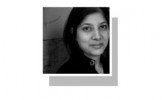A GENERAL election is like a democratic health check. In its wake, comes the prognosis: will Pakistani democracy live or die? The widely discredited polling process points to terminal illness. But many pro-democracy Pakistanis believe we have identified a possible cure in the form of the youth vote.
The local and international media has a clear narrative: the triumph-against-all-odds of PTI-affiliated candidates was delivered by social media savvy young voters; their engagement with TikTok videos and AI-generated rallying cries has checked the excesses of elite institutions and vested interests. Ahsan Iqbal attributed polling results to a “youth rebellion against traditional politics” and called for “older parties … [to] create spaces for these segments in their party structures”.
But has democratic backsliding truly met its generational match? In some ways, this election was bound to belong to the youth: our country’s median age is 22.7 years, and more than 56.8 million eligible voters were under 35. But will young voters remain engaged in a sustainable way?
An election is cathartic. This year’s polls invited acts of defiance, which suited Imran Khan’s politics of disruption. Were the youth votes cast akin to an expletive against entrenched political actors and institutions? Or do they signal a revival of political engagement in the sense of policy development, institution building and service delivery?
The youth bloc is not a monolith.
The signs do not breed optimism. Firstly, the key issues that matter to young Pakistanis — inflation, education, employment — received only scant attention in parties’ manifestos. As service delivery falters, young voters will be disappointed.
Indeed, while they may have cast votes, young Pakistanis have been voting with their feet for the past few years. A survey from the Pakistan Institute of Development Economics last year found that 67 per cent of young Pakistanis want to leave the country in pursuit of employment. The number of Pakistanis emigrating tripled between 2021 and 2022, with the trend continuing last year.
Youth electoral fervour is also disengaged from Pakistan’s political economy and structural challenges, which must be addressed as a prerequisite to democratic revival. A VOA/ Ipsos survey in the run-up to the elections found that 74pc of young voters trust the military, while 58pc rank the Supreme Court as the second-most trusted institution. Such beliefs are hardly the precursor to a status quo shake-up.
Research from the University of Cambridge’s Centre for the Future of Democracy may shed light on the youth phenomenon in these elections. The 2020 Youth and Satisfaction with Democracy report (which maps global trends) found that satisfaction with democracy is declining most rapidly among 18-34 year olds, with 55pc of global millennials (born between 1981 and 1996) expressing dissatisfaction. This is largely driven by the inability of democratic governments to address youth unemployment, wealth inequality and other forms of ‘economic exclusion’.
That said, the report identified an interesting quirk: countries with populist leaders like Khan logged a 16 percentage point jump in satisfaction with democracy among voters aged under 35 years during the first few years of a populist’s tenure. This turnaround effect was noted irrespective of whether the populist leader was left- or right-wing. And it occurred despite the polarising effects of populist politics, which should be anathema to democracy.
But the report also found that an uptick in youth satisfaction with democracy under populist politicians is short-lived, with satisfaction declining gradually after four years, and precipitously after two terms. In other words, as populists either turn authoritarian to preserve power, or temper their excesses in order to succeed as mainstream politicians, they lose their youthful support, and democracy suffers again.
The conduct of Imran Khan and his supporters in opposition will steer the nature of youth political engagement, with perceptions of complicity a key risk. In all scenarios, it would be a shame for all parties and democracy champions not to seek to sustain youth participation.
We need more data to better understand Pakistan’s demographic political trends. This should include tracking various forms of political engagement beyond casting ballots. Everything from social media engagement and protest to consumer boycotts counts, and acknowledging this will help clarify how to sustain youth engagement. We must also nuance the debate: the youth bloc is not a monolith, and grassroots circumstances will shape different young voters differently. Giving them due respect at a granular level — through participation in local government bodies — is likely to be a key step in sustaining engagement.
The writer is a political and integrity risk analyst.
X: @humayusuf
Published in Dawn, February 19th, 2024
Young voters
 132
132
 1
19.02.2024
1
19.02.2024
A GENERAL election is like a democratic health check. In its wake, comes the prognosis: will Pakistani democracy live or die? The widely discredited polling process points to terminal illness. But many pro-democracy Pakistanis believe we have identified a possible cure in the form of the youth vote.
The local and international media has a clear narrative: the triumph-against-all-odds of PTI-affiliated candidates was delivered by social media savvy young voters; their engagement with TikTok videos and AI-generated rallying cries has checked the excesses of elite institutions and vested interests. Ahsan Iqbal attributed polling results to a “youth rebellion against traditional politics” and called for “older parties … [to] create spaces for these segments in their party structures”.
But has democratic backsliding truly met its generational match? In some ways, this election was bound to belong to the youth: our country’s median age is 22.7 years, and more than 56.8 million eligible voters were under 35. But will young voters remain engaged in a sustainable way?
An election is cathartic. This year’s polls invited acts of defiance, which suited Imran Khan’s politics of disruption. Were the youth votes cast akin to an........
© Dawn
 visit website
visit website






















 Toi Staff
Toi Staff Gideon Levy
Gideon Levy Belen Fernandez
Belen Fernandez Andrew Mitrovica
Andrew Mitrovica Mort Laitner
Mort Laitner Rami G Khouri
Rami G Khouri Ali Fathollah-Nejad
Ali Fathollah-Nejad Nikkei Editorial
Nikkei Editorial
